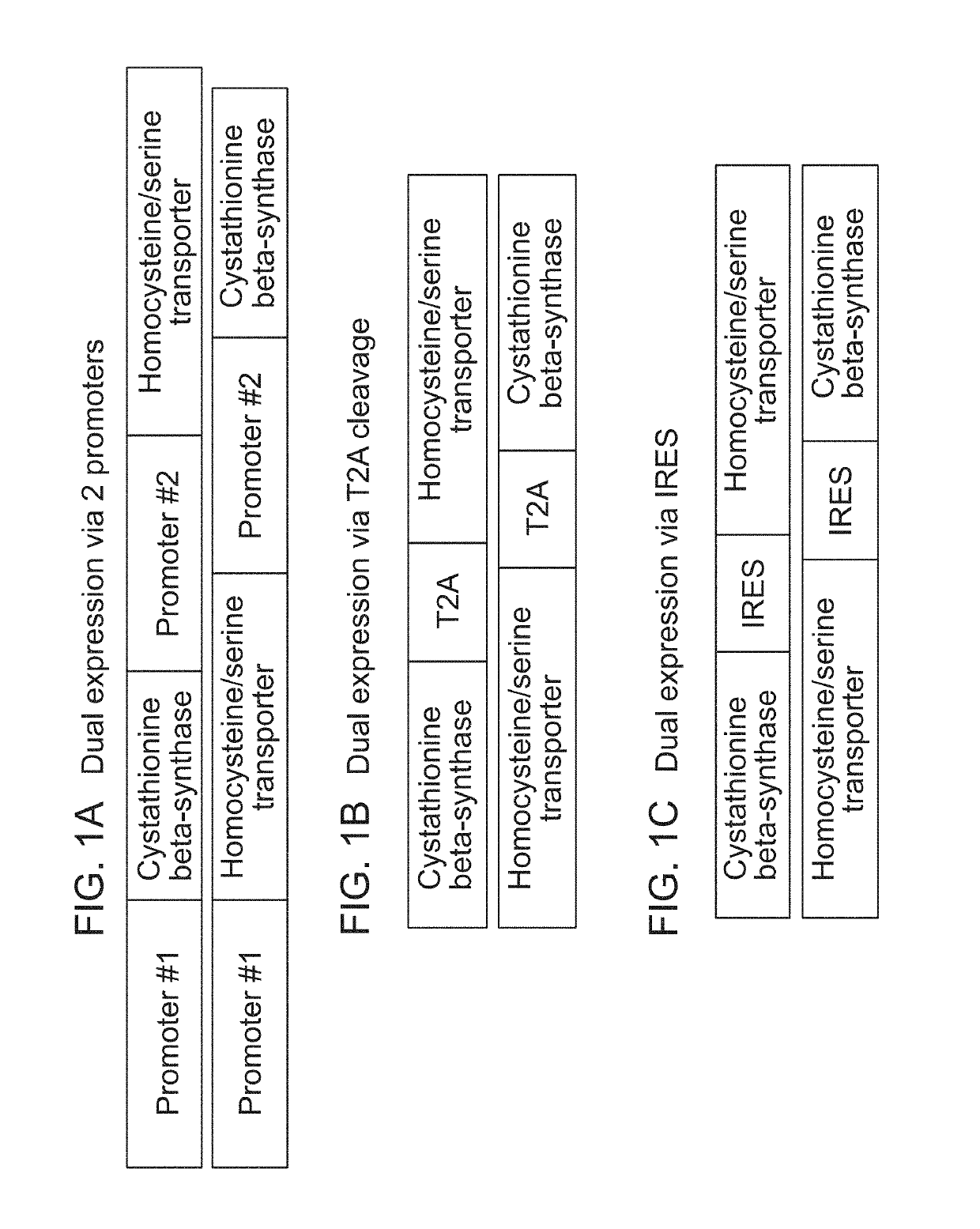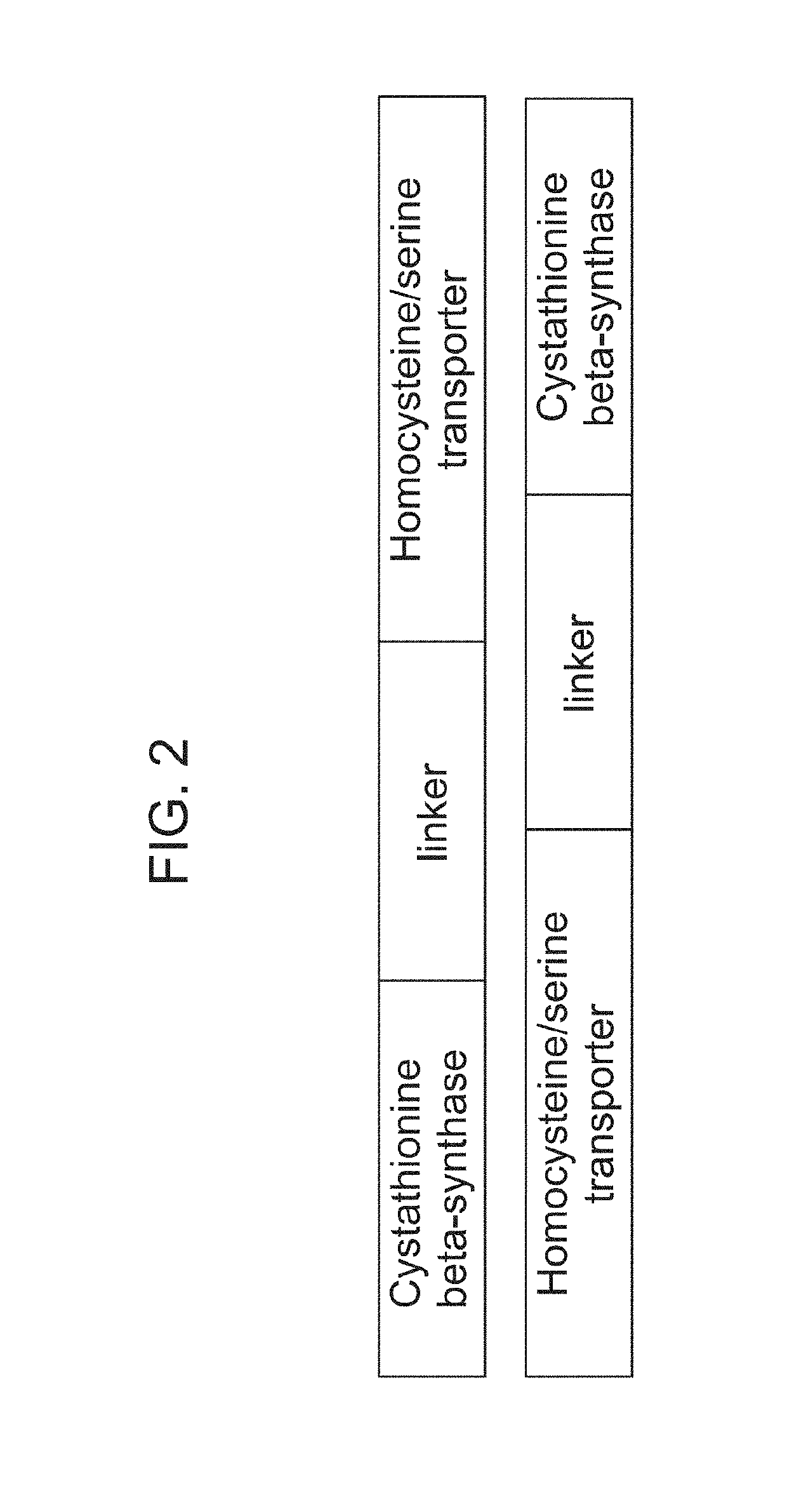Therapeutic cell systems and methods for treating homocystinuria
- Summary
- Abstract
- Description
- Claims
- Application Information
AI Technical Summary
Benefits of technology
Problems solved by technology
Method used
Image
Examples
example 1
Generation of Erythroid Cells Genetically Engineered to Comprise Cystathionine Beta-Synthase
Production of Lentiviral Vector
[0639]A lentiviral vector is constructed with a gene encoding cystathionine beta-synthase under the control of the MSCV promoter. Lentivirus is produced in HEK-293T cells by transfecting the cells with pPACKH1 (System Biosciences) or in-house made packaging vector mix and the constructed lentiviral vector using TransIT-LT1 transfection reagent (Mirus). After 12-14 hour incubation, cells are placed in fresh culturing medium. The virus supernatant is collected 48 hours post-medium change by centrifugation at 1,500 rpm for 5 minutes. The supernatant is collected, filtered through 0.45 μm filter, and frozen in aliquots in −80° C.
Expansion and Differentiation of Erythroid Cells
[0640]Human CD34+ cells derived from mobilized peripheral blood cells from normal human donors are purchased frozen from Fred Hutchinson Cancer Research Center. The expansion / differentiation pr...
example 2
Generation of Erythroid Cells Genetically Engineered to Comprise Methionine Gamma-Lyase
Production of Lentiviral Vector
[0643]A lentiviral vector is constructed with a gene encoding methionine gamma-lyase under the control of the MSCV promoter. Lentivirus is produced in HEK-293T cells by transfecting the cells with pPACKH1 (System Biosciences) or in-house made packaging vector mix and the constructed lentiviral vector using TransIT-LT1 transfection reagent (Mirus). After 12-14 hour incubation, cells are placed in fresh culturing medium. The virus supernatant is collected 48 hours post-medium change by centrifugation at 1,500 rpm for 5 minutes. The supernatant is collected, filtered through 0.45 μm filter, and frozen in aliquots in −80° C.
Expansion and Differentiation of Erythroid Cells
[0644]Human CD34+ cells derived from mobilized peripheral blood cells from normal human donors are purchased frozen from Fred Hutchinson Cancer Research Center. The expansion / differentiation procedure co...
example 3
Generation of Erythroid Cells Genetically Engineered to Comprise Homocysteine and / or Serine Transporter
Production of Lentiviral Vector
[0647]A lentiviral vector is constructed with a gene or multiple genes encoding homocysteine and / or serine transporter under the control of the MSCV promoter. Lentivirus is produced in HEK-293T cells by transfecting the cells with pPACKH1 (System Biosciences) or in-house made packaging vector mix and the constructed lentivirus vector using TransIT-LT1 transfection reagent (Mirus). After 12-14 hour incubation, cells are placed in fresh culturing medium. The virus supernatant is collected 48 hours post-medium change by centrifugation at 1,500 rpm for 5 minutes. The supernatant is collected, filtered through 0.45 μm filter, and frozen in aliquots in −80° C.
Expansion and Differentiation of Erythroid Cells
[0648]Human CD34+ cells derived from mobilized peripheral blood cells from normal human donors are purchased frozen from Fred Hutchinson Cancer Research ...
PUM
| Property | Measurement | Unit |
|---|---|---|
| Fraction | aaaaa | aaaaa |
| Volume | aaaaa | aaaaa |
| Fraction | aaaaa | aaaaa |
Abstract
Description
Claims
Application Information
 Login to View More
Login to View More - R&D
- Intellectual Property
- Life Sciences
- Materials
- Tech Scout
- Unparalleled Data Quality
- Higher Quality Content
- 60% Fewer Hallucinations
Browse by: Latest US Patents, China's latest patents, Technical Efficacy Thesaurus, Application Domain, Technology Topic, Popular Technical Reports.
© 2025 PatSnap. All rights reserved.Legal|Privacy policy|Modern Slavery Act Transparency Statement|Sitemap|About US| Contact US: help@patsnap.com



